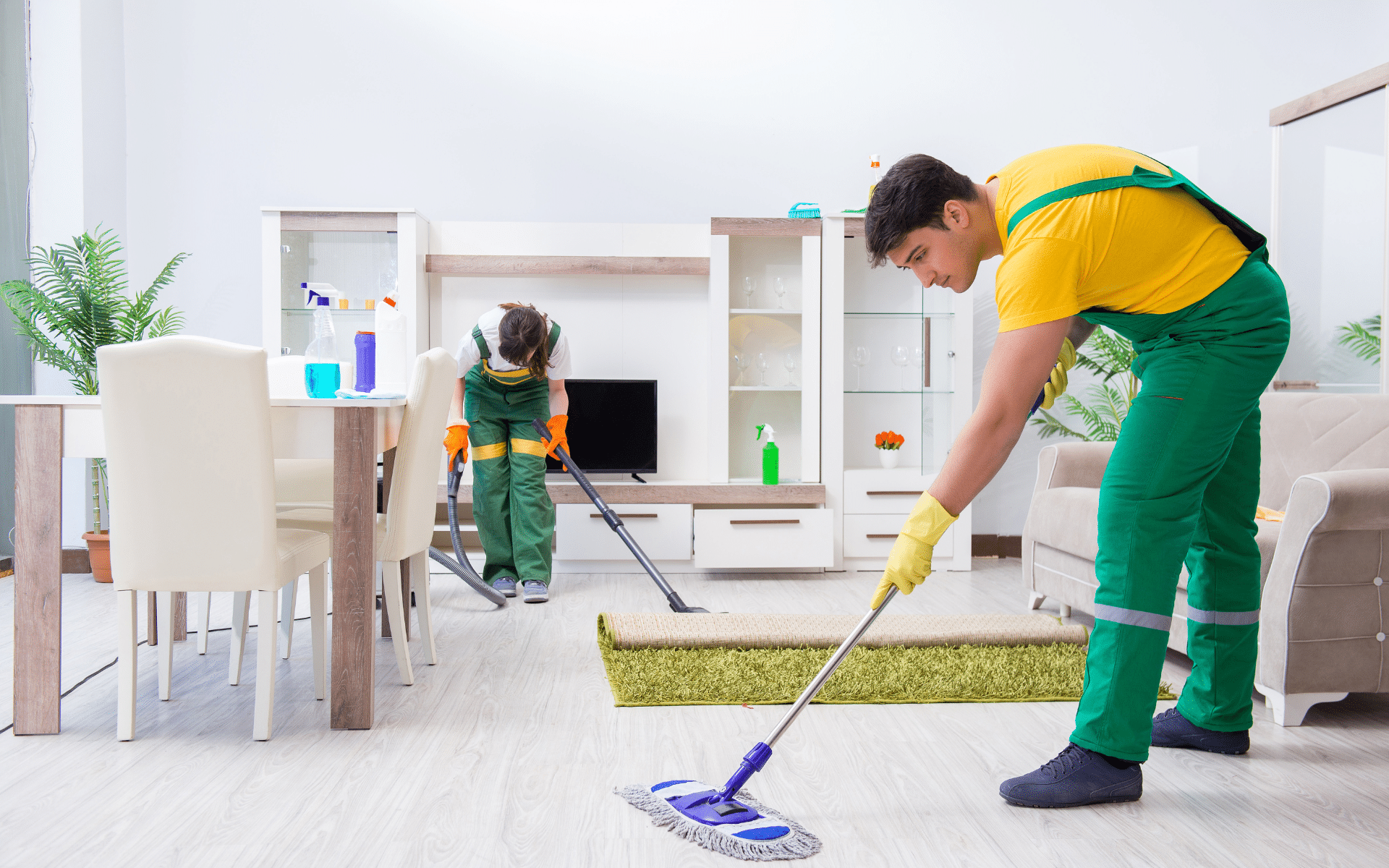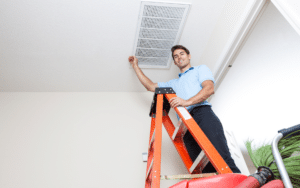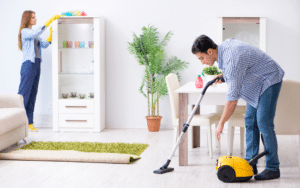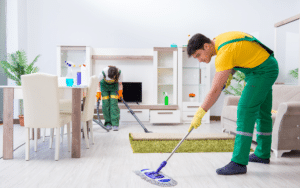Does dust constantly seem to accumulate in your home no matter how much you clean? You’re not alone. Dust buildup is an endless annoyance in many households. The good news is there are simple, effective ways to reduce household dust so you can breathe easier.
Implementing simple habits can cut down on dust buildup in your home. Or call on professional cleaning company services for a deep cleaning. In this article, we’ll share seven easy habits you can build into your routine to cut down on dust in your living spaces.
Easy Ways to Reduce House Dust
1. Put Down Doormats
One of the easiest ways to reduce dust mites in your home is to minimize what gets tracked inside in the first place. According to the Natural Resources Defense Council (NRDC), dust exposure increases when dirt particles are brought indoors via shoes. Place doormats outside all exterior doors as well as right inside your home’s entrances.
The rough mat surfaces help scrape off and trap dirt and debris from shoe bottoms before they get spread around your interior floors and carpets. Choose mats with sturdy fabrics that can brush away particles trapped in shoe treads. Just be sure to shake them out frequently. Doormats stop house dust at your door and make house cleaning easier.
2. Change Sheets Often
Did you know your cozy bedding harbors a ton of dust? As you sleep, you shed dead skin cells, which then collect in sheets, pillowcases, and blankets. To cut down on dust, aim to wash bedding weekly. Swapping out pillowcases, sheets, duvet covers, mattress pads, and comforters for fresh laundered versions reduces dust buildup from dead human skin cells, oils, and sweat.
Washing also gets rid of dust mite allergens that can accumulate in bedding. This is especially important if you have dust mite allergies. Changing sheets weekly and replacing pillows annually are easy ways to lower dust in the bedroom. Tackle bedding on “laundry day” so you don’t forget this important dust-busting ritual.
3. Dust and Wipe Surfaces
In addition to quick daily dusting, setting aside time for weekly comprehensive dusting is important. Go room to room using microfiber cloths, feather dusters, or extendable dusters to remove dust from all surfaces. Start at the top and work your way down – lamps, ceiling fans, shelving, wall hangings.
Don’t forget inside often-overlooked spots like wall crevices, window and door frames, vents, and moldings where dust gathers. Move appliances to dust behind and underneath them. Safely lift and dust under small décor items. Check for dust along baseboards and the tops of door frames too. Slow and thorough dust removal clears away the buildup.
4. Vacuum Regularly
Frequent vacuuming keeps dust levels down in carpeted areas. House dust mites get ground into fibers when people walk over rugs and carpets. Vacuuming not only cleans visibly soiled surfaces but lifts away millions of tiny embedded allergen particles and returns air quality improving circulation.
Use crevice tools to vacuum inside corners, along edges, and in tight spots. Periodically replace filters and bags so suction power stays strong. For optimal dust and pollen removal, vacuum heavy traffic areas like halls and entryways at least every other day, and all rooms twice a week. Regular vacuuming reduces allergens and improves air.
5. Own Less
Excess clutter and knick-knacks provide more surfaces for household dust to settle on. Keep flat surfaces clear of non-essentials. Store away items not regularly used so there are fewer dust traps. For items that remain out, group together on shelves rather than scattering about to make dusting easier.
Get rid of excess papers, piles of magazines, and unused items taking up space. According to environmental health experts, owning less used materials creates less opportunity for dust buildup. Keeping your home tidy and decluttered reduces dusting time and effort.
6. Clean Air Vents
Don’t forget indoor air vents as a spot where dust accumulates. Air ducts circulate dust samples through a home’s ventilation system. Vents, returns, and registers should be cleaned 1-2 times per year as part of reducing airborne allergens. Use a vacuum with a soft brush attachment to gently suction away debris around the vent covers. Then remove covers and use a duster to dislodge built-up dust inside duct openings, vacuuming as you go. Proper vent cleaning improves indoor air quality.
7. Groom Pets
Pets can be big contributors to household dust, especially if they go outdoors. Pollutants from pet dander and hair trapped in their coats get released into the home and circulated through ventilation. Brush or comb your cats and dogs frequently to remove loose hair and dander rather than allowing it to shed onto indoor surfaces. Bathe pets weekly if possible. Also, vacuum upholstered furniture to remove embedded pet hair and allergens. Keeping pets well-groomed lessens the dust they bring inside.
Best House Cleaning Tools
When it comes to effectively removing household dust, having the right tools makes a big difference. Here are some of the best options for tackling dust buildup:
- Microfiber cloths – The tiny microfibers grab and cling to fine dust particles, great for wiping down flat surfaces. Dampen just slightly for best dust removal.
- Feather dusters – The fluffy feathers disturb and whisk away dust on surfaces like window blinds, fans, and lampshades. Swipe gently to prevent scattering.
- Vacuum cleaners – For dusting carpets, rugs, curtains, and upholstered furniture, vacuums are ideal. Models with HEPA filters trap allergens.
- Compressed air – Canned compressed air is great for dusting electronics and keyboard areas. Just avoid tilting the can for best results.
Having the right dusting tools and chemicals on hand makes keeping your home’s surfaces dust-free much simpler. Invest in quality microfiber cloths, dusters, and vacuums designed for dust removal.
Consider Professional House Cleaning Services
Keep dust under control by booking a regular professional cleaning service. The right cleaners can thoroughly tackle dust magnets like ceiling fans, baseboards, window blinds, and under furniture that’s hard to reach. While an investment, professional services give you back time on the weekend for family fun instead of endless chores. Regular cleanings also keep dust from accumulating, which is harder to handle if you only do deep cleanings every so often.
Bottomline
From skin cells to airborne particles to dirt particles, dust constantly accumulates in homes. Implementing these simple habits reduces allergen particles and improves indoor air quality. Deep cleaning by house cleaning professionals can also help tackle dust for a fresher home. With diligent daily dust removal and periodic deep cleanings, you can enjoy cleaner indoor air!





